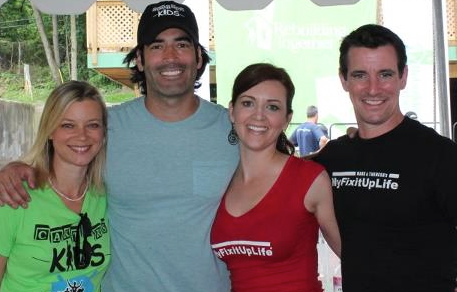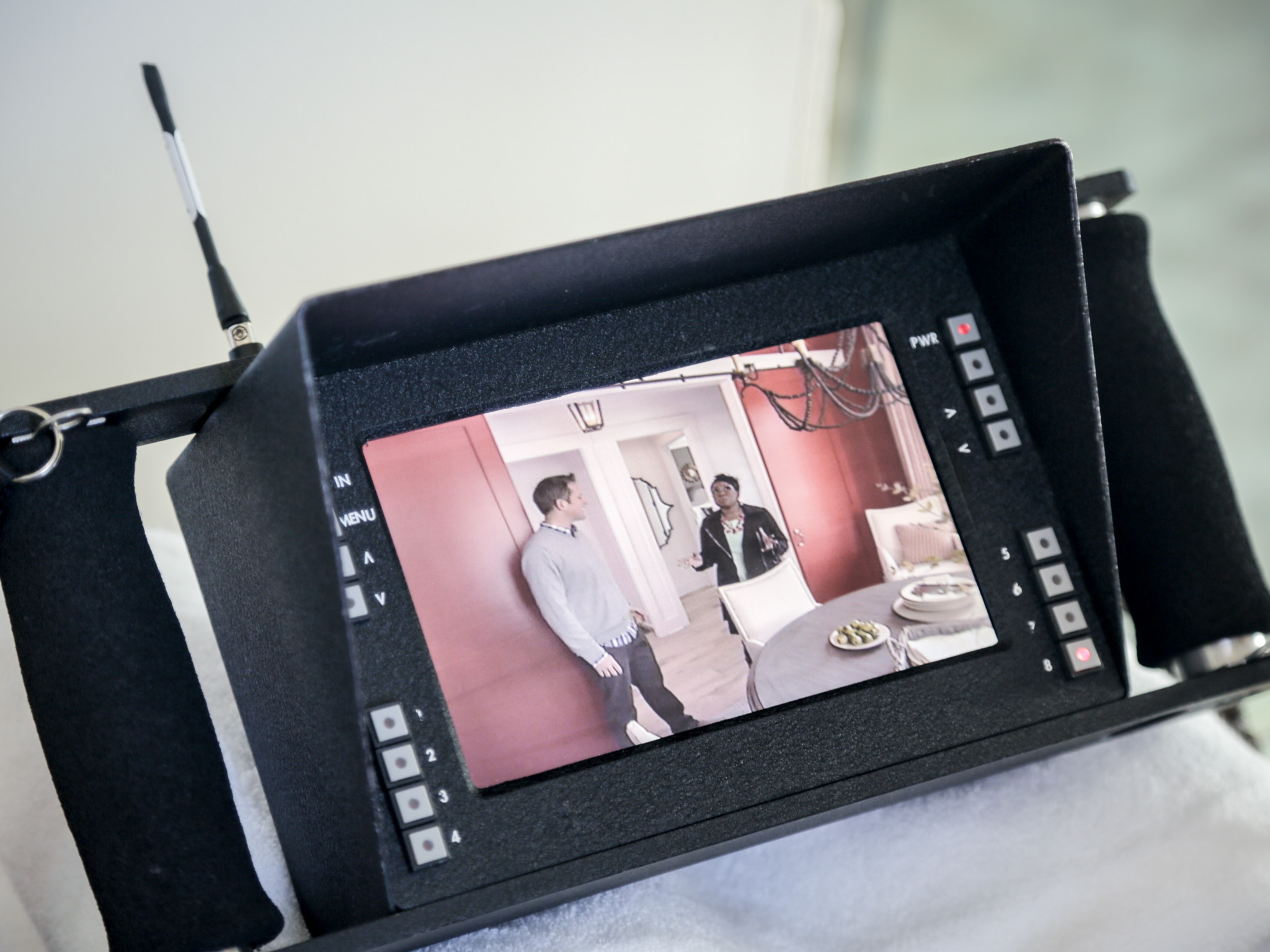Home improvement professional and HGTV star Mike Holmes takes a break from his hectic schedule to talk with Mark & Theresa. Check out the interview:
Mark: And you are inside MyFixitUpLife and we are in an undisclosed location at the International Builders’ Show with my wife Theresa.
Theresa: Yes, it’s a secret location.

Mark: That’s right.
Theresa: Shhh don’t tell anyone.
Mark: Okay I’ll try not to. It’s so secret that it’s a hotel lobby. But we have up and moved the show to spend a few minutes with none other than make it right himself, Mike Holmes.
Mike: How ya doing? It’s been a while hasn’t it?
Theresa: It has, it’s been a whole year. And you look really good.
Mike: Why thank you. Alright I’ll fix your house, see that was easy.
Theresa: Nice…I like it, I like it.
Mark: We could use some help. We have a typical carpenter’s house where we’ve worked on everyone else’s house.
Mike: Why would you work on everyone else’s and not your own?
Mark: You know it just worked out that way. It didn’t use to be that way.
Theresa: Our house is about 80% done right now.
Mike: So you’re working on that part time right now, you’re so busy doing other things that when you have the time.
Theresa: Well we have that lifestyle where we photograph and video everything that we do because we write about it for magazines, you know how to, websites — the whole thing. And we do videos so we have to, like it’s a part of our whole business and our whole life is fixing up our house so it takes a lot longer.
Mark: So it takes like a week and a half to put on a piece of shoe molding is what it comes down to.
Theresa: Yes.
Mike: Oh you do need my help, don’t you?
Mark: Yes, yes we do. And we’ve got a full gut reno on a 100-year-old house so it’s a block house, all the inside plaster and lath comes down so it’s all the lead RRP stuff that you’re familiar with. Cause it is, you know you press the lead test thing and it turns bright pink.
Mike: So you know you have to have masks? Did you check the plaster for a 1:5 ratio of asbestos before you took it down?
Mark: No.
Theresa: No, no we didn’t.
Mike: You should. Anything before 1980 check it for asbestos. You just call in a company that does a quick check. They do a plaster scrap, they’ll check for the lead — obviously you know, you did the pink pen test. But I highly recommend don’t ever touch your house before you check it because asbestos will hook to your lungs. It’s a fish hook. And they are very small and they’ll never leave your body. And you’re gonna have them forever and I just really don’t think it’s a good idea you breathing that in.
Theresa: Well I’m pretty sure there’s probably asbestos in our house because asbestos was invented in the town we live in.
Mike: Then more than likely. The reason why there was a 1:5…that’s usually not good. So I wouldn’t worry about it…you live there right? You go in the house not to breathe outside air. Ha Ha



Theresa: Yeah, it’s a big problem in our town.
Mark: Seriously, they’re burying tailings still — tailings are the bi-product of the manufacturer of that stuff.
Mike: Asbestos itself is such a wild binder. That’s why they use it as a binder. Also a heat source or protection for pipes. It’s a great product, it’s just a deadly product to humans and I don’t think we pay enough attention to that.
Theresa: Well it’s a good thing to pay attention to because a lot of our neighbors were affected and have lost loved ones because of it. Working in the plant and because of having it in their homes and everything and it’s something that’s really important to our town.
Mark: It’s a legacy, and it’s strange because it was like a global hub of asbestos before anybody knew what it was. And now it’s not.
Theresa: And the houses that were built are just gorgeous because there’s like basically a castle — the guy that invented asbestos his home literally looks like a castle.
Mike: He probably made a lot of money.
Theresa: Yes.
Mark: He made a few bucks.
Mike: And then some actually.
Mark: So yeah and the RRP training remodel — it’s the EPA training here, which I’ve taken and I know what’s in it, except I can’t remember what it’s called. Remodel…renovate and paint. It’s the EPA training for working with lead here in the States. Not one word about asbestos in that.
Mike: Uh, I’d worry about that. It is a rule of thumb for anyone that is going to renovate — it should be, it’s actually somewhat of a law, but it’s never pushed out it’s never been told, anything before 1980 do not renovate unless you do a complete test of your home. Just don’t. It’s not good for your health; it’s not good for your kid’s health.
Theresa: Boy am I glad that you stopped by to talk to us.



Mark: And that sort of leads me to another question where sometimes — I don’t know if you know this, but remodels go wrong…
Theresa: Occasionally.
Mark: Occasionally they go wrong.
Mike: I’ve seen it a couple times.
Mark: Couple times. And even, and this isn’t to catch you in anything but it happens to all of us who work on houses where things go wrong. The delivery doesn’t come, you have the roof off and it snows — things that are beyond your control, and my question to you is 1. If you have a story like that you could share it, and 2. What’s the take away so that contractor and customer can work together when the forces of nature sort of conspire against success?
Mike: I’m a freak for protecting your home. It’s funny that I call myself a freak, but I am. I’m the guy that if I’m working on, let’s says a second story addition; every single day I leave it’s tarped. It’s tarped tight like you can’t imagine. One day — this had to be like 25 years ago — I was doing a second story addition and it was a beautiful day, the sun was shining, we’re working like crazy, and I just happened to stand up and look to my left and it was the darkest wave of a storm coming out of nowhere. And it wasn’t supposed to rain, I pay attention to this. I started yelling, ‘Get the tools put away, get the tarps, get the tarps!’ I’m yelling at everyone. We had just gotten the tarps on the house and it came down, I mean buckets of water and oh we got wet. The house got wet, we tried really, really to get on this. One of my guys was at the edge of the roof holding his corner of the tarp down and the wind came up under and pulled the tarp up and lifted him off the roof.
Theresa: What!?
Mike: He landed back down on the roof, he did not go off the roof, which I was really happy to see, and that was it, we got it down but I swear since that day I really pay attention to weather. Cause that was not only was it dangerous but it cost me some money — I had to fix some things inside the house.
Mark: Because the water got in?
Mike: Oh it did, it was just too much rain. It was just huge amounts of rain, it was like golf balls.
Theresa: And you never know what’s going to happen too. Even if it’s not supposed to rain that night or the next morning or whatever it is, there might be something that happens that you can’t get back to the jobsite and there is another thing coming — there is always something that comes up in life.
Mike: I think wind is the biggest enemy cause it can take things off that you have put on to protect that house, such as tarps.
Mark: Yes, it’s only a tarp, there’s only so much you can do with it.



Mike: Well communication is key. You have to talk to the home owners and say this is what we’re gonna be doing, I need you to pay attention, if we are gone for two days — maybe we’re on another job, for whatever reason, we’re waiting for material like you said, contact me if you see any issues, any tarp flying in the wind I need to get back there because I don’t like ruining people’s houses, I like actually fixing them.
Theresa: That’s a really good motto to live by actually. I kind of really appreciate that.
Mike: Well you can’t charge them to fix it because it’s under construction and it dumped down rain, you can’t charge them for that, that’s your problem.
Mark: That’s true.
Mike: Yeah I don’t like that problem
Mark: Now do you find that in the inspections program that you do that as you go back and you go through these homes and you start to peel away that you find the results of stuff that happened that people inadvertently did, didn’t know they weren’t doing right and it’s getting covered up and it’s buried and we’ve seen millions of junctions that should have junction boxes and things like that, but water that got in that never came out, that kind of stuff?
Mike: Well water always has a path — it shows it’s been there, it always leaves a mark weather its affluences to salt in the water, it will always leave a mark. So it’s not like you’re gonna have a bucket of water up in the ceiling and it’s waiting to come down one day, that’s not gonna happen. Do I see it? Yes. I’ll tell you, how many houses have I gone into and in ten minutes and went ‘Oh you’re screwed’. Ten minutes. And I know I’m screwed because I have to fix it. I’m like ‘I’m screwed…I’m screwed and you’re screwed’. I remember this one job that we took the bathroom apart and I knew it had been covered up, but what I didn’t know, it had been covered up four times. Literally tiled over, dry walled over, closed over, windows closed over. I could not believe it. It was probably a 40 yard bin I filled to gut this bathroom.
Mark: Bathroom?
Mike: Yes, and there was mold galore. Any time you cover things up, like I’m not a big guy of cover up, I don’t like band aids, I don’t like those ‘tub in a day’ — I love those things, well just go over all your old crap there, you’ll love it, you’ll come home to a brand new bathroom! Sorry don’t like it.
Theresa: The ‘tub in a day,’ that always makes me nervous.



Mark: But sure you’re encapsulating moisture, you’re encapsulating other problems.
Mike: You don’t cover things up.
Mark: And that water is going to evaporate out somewhere.
Theresa: It’s just going to get worse.
Mark: It’s gonna find it’s way out.
Mike: Why do you put on a, let’s call it ‘tub in a day,’ why would you do that? Because it looks ugly, it’s probably moldy, the tiles are probably falling apart, odds are there’s probably mold galore behind it…you’re gonna cover it up? Not logical. Outta sight, outta mind is that it? Not mind over matter, not mine it doesn’t matter? But it is yours.
Mark: Not mine it doesn’t matter. Yeah I’ve actually put magic into several estimates I’ve done over the years. How will this be done? Magic.
Mike: Ha Ha Ha
Mark: Hocus Pocus. Yeah that’ll be $200 please.
Theresa: That’s a very expensive line item.
Mark: Yeah, I gotta line item it out.
Theresa: There’s a lot of equipment involved in creating the magic.
Mark: Well yeah, and as far as planning goes, for doing odd ball stuff that’s gonna involve cranes and things of that nature, for the contractor’s that are listening you know many contractors live in the free estimate business. I’ll give you a free estimate — it takes them, a good one for a complicated job, two days to put that together.
Mike: It does.
Mark: What advice do you give to those professionals who are aware that that is money time, is paid time?
Mike: To the professionals that do that, they’ll find and I’m sure they even track themselves, that they get the job. Because they take the time, and they do it right. They’re not the guys that walked in with the clip board and within 30 minutes said okay it’s gonna be 25 grand I want 20 grand down, sign here. You know all you got was his business card you didn’t see anything else. So the pros that take that time, they more than likely educated the homeowners they’ve talked to them well, and they get the job. That’s why they keep doing it. If you miss one out of ten, that’s not a bad sign. That’s not a bad thing; maybe you don’t wanna work for that person because if they didn’t like your price they went for the cheaper price.
Theresa: If they’re only shopping on price, that scares me.
Mike: I don’t wanna work for people like that. I show them how to spend their money. This is what you need to know. We used nothing but mold resistant products, zero VOCs, we’re gonna find duck work in those walls. So let them know along the way, and that’s all priced out and tells you. I charge $500 a week to clean your house. Why? Because every single day before I go home, we clean your house. So $500 a week goes to clean and delivery. That’s a charge. There’s no negotiating.
Mark: That’s awesome. Now on the other side of the coin, because I love that thoroughness, both as a business owner it teaches you this is what I’m spending my time on, as a homeowner it says this is what he’s spending his time on, and they can check against it. But have there been cases where you’ve said, you know what I’m gonna fire the client? We’re not a match.
Mike: For me personally?
Mark: Yes, for you personally.
Mike Actually yes. And I’ll do it in a different way. It’s only happened about 3 times in all my life. Some people are just impossible to please. It doesn’t matter how much you told them, how much you tell them ahead of time, they got it in their head, they want it their way, and if you do it their way and it’s wrong they want you to replace it. And eventually I’ll say you know what, this is why I do the even steven rule ok, this means you pay as I go. I want a small down at the beginning. When this part is done I want my money, when this part…so it’s in milestones. Now that protects the homeowner but it also protects me because at that time I can go okay this is all done, I’ve had enough here and if you have any more issues, I won’t be doing this and you can find somebody else to do this. You’re not out of pocket.
Theresa: Easy way to walk away.
Mark: Well we have not had enough, but unfortunately we have to take a break.
Theresa: We do.
Mark: Right now, Mike Holmes, makeitright.ca and consummate craftsman, thank you for joining us.
Check out the MyFixitUpLife talk show that features this interview with Mike Holmes.









